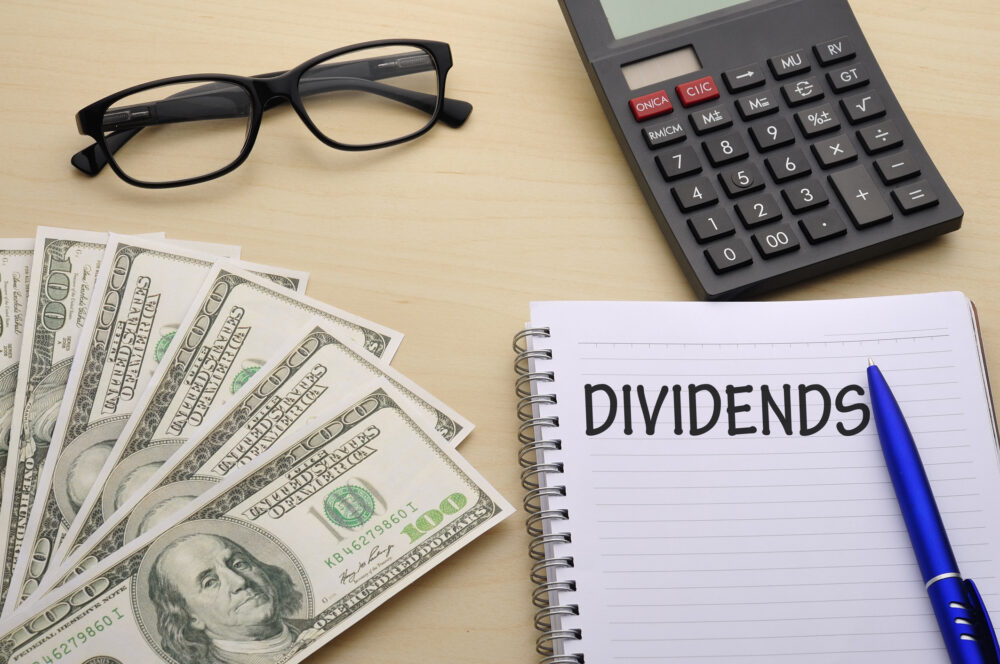A dividend is a payment that a company makes to its shareholders and owners from the profits it earns.
When a company makes a profit, it can be reinvested in the business or distributed to shareholders as a dividend. All the companies do not pay dividends.
How does it work:
- When the company retained its profit.
- The company decides to distribute part of the profit to shareholders instead of reinvesting.
- The board of directors approves the amount of the dividend.
- The company declares the due date.
- Finally, the dividend is paid to the shareholders.
Types of Dividends

There are different types of dividends a company can pay, let’s discuss one by one in detail:
-
Cash Dividend
A cash dividend is a payment from the company to the shareholders in the form of cash. It is the most common type of dividend payout. The board of directors announces to pay the pre-decided amount on a specific date directly to the bank or in the form of checks.
-
Stock Dividend
Stock dividend is the distribution of new shares of the company among the shareholders without any consideration. If the issued shares are less than 25 percent of the total number of shares, then it will be considered a stock dividend.
-
Property Dividend
The companies are not limited to issuing dividends in the form of cash and shares, they can also issue non-monetary dividends for property, physical assets, etc. Although, it is practiced in very few companies.
-
Special Dividend
Sometimes companies pay dividends without the normal policy of dividends. They pay quarterly or annually due to excess cash in hand or maybe some other reason.

Source: fool.com
-
Scrip Dividend
In some cases, companies do not have enough funds to distribute among the shareholders. So, they issue a scrip dividend which is a loan contract in which a later date of issuance is mentioned.
-
Liquidating Dividend
When the company seems to shut down and cannot stand further and does not have further funds, then the board of directors decides to return the original share invested by the shareholders as a dividend is known as a liquidating dividend.
-
Other Dividend
Some companies pay another dividend in the form of warrants or shares of some new company etc.
What is a Corporation Tax?
It is a tax on the company’s total annual income. Taxes apply only to revenue excluding marketing costs, depreciation, development, and other operating costs are known as corporate taxes.
Corporate tax rates are different from country to country and can be reduced by various deductions like government subsidies or some technicality.
Dividends Corporation Tax

A certain amount of tax is charged on the dividend because it represents the profit of the company. The shareholder also pays tax as soon as the dividend is received.
If you want to study in detail about dividends, “How and Why Do Organizations Pay Dividends?” please read the article Dividends Corporation Tax provided by Legend Financial.
Corporate Interest Restriction – CIR Rules Overview
The limitations on the amount of interest deduction that a company may declare to calculate its profit for UK tax purposes is known as Corporate Interest Restriction (CIR). It should be noted that the relief given for the financial cost is proportional to the business activities according to the UK corporation tax.
The Debt Cap Rule:
This rule limits the borrowings in the UK group to the external borrowings in the rest of the world. In short, if the total UK expenses are greater than the gross group cost, excess is not allowed.
Restrictions on Corporation Tax Relief for Tax Deduction
The corporate interest restriction is only applied to the company or group of companies that earn more than £2 million in a year. Let a company’s net interest and financing cost is restricted; it should establish a reporting company for 12 months. In this way, that reporting company has to submit a corporate interest restriction return.
If you are interested about what are the current interest rates of late payments and how to manage late payments, you can go through this article Interest on corporation tax allowable.
The Net Interest and Financing Cost Are Less than £2 million
In this case, the company need not represent corporate interest restriction return. Although, the documented report should show that the deduction is not more than £2 million in net interest and financing cost in that particular accounting period. The future interest deduction can be reduced by using carry forward interest allowance of up to 5 years.

Source: bbva.com
The Net Interest and Financing Cost Are More than £2 million
A company can formulate an interest allowance to deduct the maximum amount of net interest and financing cost in 12 months. Records of calculations should be required for further operations. There are two methods used, a company can opt for the method which gives the largest amount of allowance.
Fixed Ratio Method:
In the fixed ratio method, the tax allowance is lower. The company will get 30% of the UK taxable income before interests, taxes, depreciation, and others. The net interest expense of a company or group worldwide.
Group Ratio Method:
- A company needs to designate the reporting company first.
- Choose the method in a corporate interest restriction return.
- The company or group’s net profit before tax, interest, depreciation, and amortization and the company’s or group’s global net interest expense ratio attributable to unrelated parties multiplied by the company’s or group’s UK taxable profit (before interest and capital reserves) ratio.
Tax Accounting

Source: clouds. ph
Tax accounting is the process of preparing tax returns and planning for future taxable years of an entity.
The main difference between financial accounting and tax accounting is as follows:
- It only focuses on transactions affecting the tax charge.
- It also looks at how the transactions relate to accurate calculation and document preparation.
- It involves accounting methods that concentrate on taxes rather than how the statement looks like.
- It is very important to realize that law can vary from continent to continent, country to country, and city to city.
- Taxation principles usually differ from accounting principles or standards otherwise known as generally accepted accounting principles (GAAP).
What does a Tax Accountant Do?
Tax advisors review, analyze, and interpret accounting records to prepare financial statements, provide advice, or review and evaluate reports prepared by others.
Tax Accountants Who work for Individual Clients
- If you choose to work with individuals, you may be responsible for preparing tax returns, where you help reduce your liability when clients file returns.
- Help them to correctly fill out tax forms, inform them about future financial steps that may affect their taxes, and file taxes electronically with relevant documentation so that customers receive their refunds as quickly as possible.
Tax Accountants Who Work for Businesses
- If you choose to work for a company, you can work as a manager in the accounting department or as a team member in the department.
- To be successful in this role, you must be familiar with all generally accepted accounting principles as well as government accounting regulations.
- You typically review company files and financial statements, prepare books of accounts, fill out tax forms, maintain contact with authorities, and hold meetings related to tax and strategy.

Tax Accounting
Conclusion
In conclusion, the dividend tax allowance, as explained by Legend Financial, is an essential part of the UK tax system and can be a great way to save on taxes for those who receive dividends. It is a necessary tool for those who wish to maximize their income and reduce their burden. The dividend tax allowance can reduce taxes and increase revenue with careful planning.




